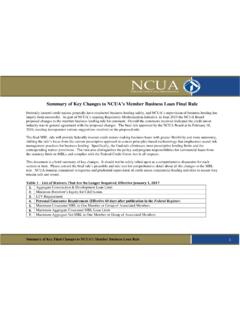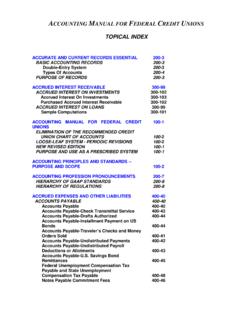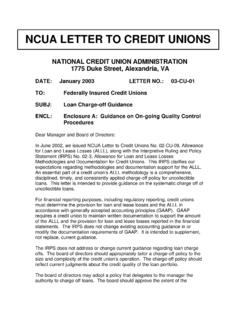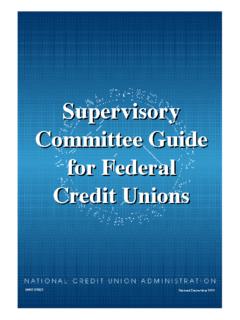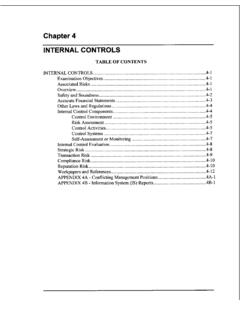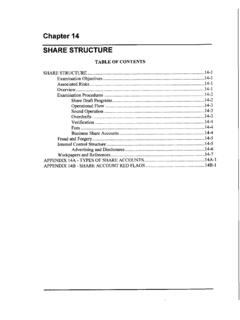Transcription of Truth in Lending Act (Regulation Z)
1 1 Truth in Lending Act ( regulation z ) The Truth in Lending Act (TILA), 15 1601, et seq., and its implementing regulation, regulation z (12 CFR 1026), were initially designed to protect consumers primarily through disclosures. Over time, however, TILA and regulation z have been expanded to impose a wide variety of requirements and restrictions on consumer credit products. The Dodd-Frank Wall Street Reform and Consumer Protection Act of 2010 (Dodd-Frank Act) transferred rulemaking authority under TILA from the Federal Reserve Board to the Consumer Financial Protection Bureau (CFPB), effective July 1, 2011. TILA is intended to protect consumers and ensure competition among financial institutions through the meaningful disclosure of credit terms, allowing consumers to compare standardized credit terms more readily and knowledgeably.
2 Before TILA was enacted, consumers were faced with a bewildering array of credit terms and rates. It was difficult to compare loans because they were rarely presented in the same format. Now, all financial institutions must use the same credit terminology and expressions of rates. In addition to providing a uniform system for disclosures, TILA: Protects consumers against inaccurate and unfair credit billing and credit card practices; Provides consumers with rescission rights; Provides for rate caps on certain dwelling-secured loans; Imposes limitat ions on ho me equit y lines of credit and certain closed-end home mortgages; Provides minimum standards for most dwelling-secured loans; and Prohibits unfair or deceptive mortgage Lending practices.
3 TILA and regulation z do not, however, tell financial institutions how much interest they may charge or whether they must grant a consumer a loan. The examinat ion procedures will use TILA interchangeably for Truth -in- Lending Act and regulation z , since regulation z is the implementing regulation. Unless otherwise specified, all of the regulation references are to regulation z (12 CFR 1026). regulation z ( Truth -In- Lending ) can be found here: Definitions Examination Procedures Associated Risks Review Considerations Examination Objectives Checklist 2 Associated Risks Compliance risk can occur when the credit union fails to implement the necessary controls to comply with TILA. Transaction risk can occur when the credit union does not have adequate internal controls in place and as a result suffers a loss.
4 Reputation risk can occur when the credit union incurs fines and penalties or decreased member confidence as a result of failure to comply with TILA. Strategic risk can occur when the board of directors fails to perform necessary due diligence in reviewing policies and procedures, and existing and prospective products and services for compliance. Examination Objectives To determine if the credit union has policies and procedures to ensure it complies with TILA. To appraise the quality of the credit union s compliance management system for TILA. To determine the credit union s compliance with TILA. To initiate corrective action when policies or internal controls are deficient, or when violations of law or regulation are identified.
5 To determine if the credit union will be required to make adjustments to consumer accounts under the restitution provisions of TILA. Examination Procedures1 A. General Procedures 1. Obtain information relevant to the area of examination from the credit unio n s compliance management system program (historical examination findings, complaint information, and significant findings from compliance review and audit). 2. Through discussions with management and review of the following documents, determine whether the credit union s internal controls are adequate to ensure compliance in the area under review. Identify procedures the institution uses daily to detect errors/violations promptly. Also, review the procedures the institution uses to ensure compliance when 1 These procedures include amendments to TILA and regulation z through June 1, 2018 and the mortgage servicing amendments effective on October 19, 2017 , or April 19, 2018, as applicable.
6 These procedures do not include the Economic Growth, Regulatory Relief, and Consumer Protection Act of 2018 amendments. 3 changes occur ( , changes in interest rates, service charges, computation methods, and software programs). Organizational charts Process flowcharts Policies and procedures Loan documentation and disclosures Checklists/worksheets and review documents Computer programs 3. Review audit or other compliance review work-papers and determine: a. The procedures used address all regulatory provisions (see Transactional Testing section). b. Steps are taken to fo llow-up on previously identified deficiencies. c. The procedures used include samples that cover all product types and decision centers. d. The work performed is accurate (through a review of some transactions).
7 E. Significant deficiencies, and the root cause of the deficiencies, are included in reports to management/board. f. Corrective actions are timely and appropriate. g. The institution reviews the area at an appropriate interval. 4. Review the credit union s record retention practices to determine whether the required documentation or evidence of compliance is retained for at least: a. Two years after the disclosures were required to be made or other action was required to be taken, other than for the advertising requirements, requirement for mortgages subject to (e), (f), and certain requirements for mortgages which are described below. ( (a)) b. Three years after the later of the date of consummation, the date disclosures are required to be made, or the date action is required to be taken, for evidence of compliance with (e)-(f) (regarding closed-end loans that are secured by real property or a cooperative unit and subject to those sections) other than as set forth in 4c below.
8 ( (c)(1)(i)) c. Five years after consummation for completed Closing Disclosure forms, and all documents related to these disclosures, as required by (f)(1)(i) or (f)(4)(i). If the loan is sold, transferred, or otherwise disposed of during that time, the credit union must provide a copy of the Closing Disclosure to the owner or servicer as part of the loan file transfer. The new owner or servicer must retain the disclosure for the remainder of the five year period. ( (c)(1)(ii)) d. Three years after the date of receipt of payment to show compliance with loan originator compensation requirements. ( (c)(2)) e. Three years after consummation to show compliance with ability-to-repay minimum standards ( (c)-(f)) and prepayment penalty restrict ions ( (g)) for loans secured by a dwelling.
9 ( (c)(3)) B. Disclosure Forms 4 Determine if the credit union has changed any TILA disclosure forms or if there are forms that have not been previously reviewed for accuracy. If so verify the accuracy of each disclosure by reviewing the following: Credit card application/solicitation disclosures ( (b)-(e)) HELOC disclosures ( (d), (e)) Init ial di sclosures ( ) and, if applicable, addit ional HELOC disclosures ( ) Periodic statement disclosures ( ) Statement of billing rights and change in terms notice ( (a),(b),(c), (g)) Note and/or contract forms (including those furnished to dealers) Notice of Right to Rescind/Cancel ( (b), (b)(1), (c)(4)) Loan Estimate ( (e), ) Closing Disclosure ( (f), ) Special information booklet ( (g)) Other closed-end credit transaction disclosures not subject to (e) or (f) ( (a), ) ARM disclosures ( (b)) High-cost mortgage disclosures ( (c)) Reverse mortgage disclosures ( (b))
10 Private education loan disclosures ( ) Closed-End Credit Disclosure Forms Review Procedures Closed-end consumer credit transactions secured by real property or a cooperative unit, other than a reverse mortgage subject to , are subject to the disclosure, timing and other requirements under the TILA-RESPA Integrated Disclosure rule (TRID). Thus, for most closed-end mortgages, including construction-only loans and loans secured by vacant land or by 25 or more acres not covered by RESPA, the credit union must provide the Loan Estimate and the Closing Disclosure. There is a partial exempt ion in (h) from the requirement to provide the Loan Estimate and Closing Disclosure if the transaction meets all of the following criteria: 1.
